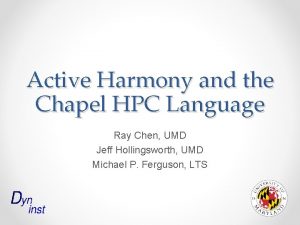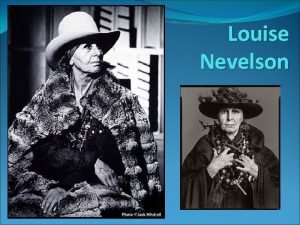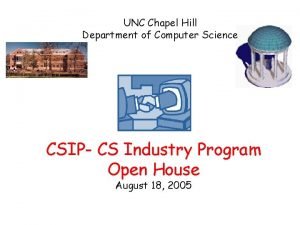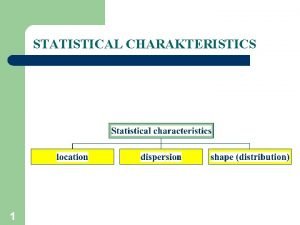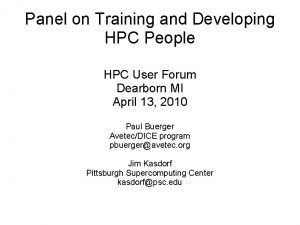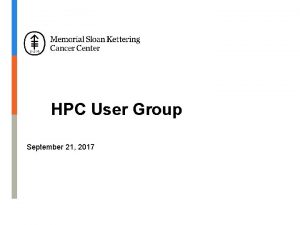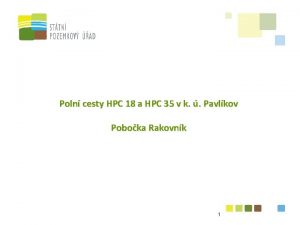Active Harmony and the Chapel HPC Language Ray





















- Slides: 21

Active Harmony and the Chapel HPC Language Ray Chen, UMD Jeff Hollingsworth, UMD Michael P. Ferguson, LTS

Harmony Overview • Harmony system based on feedback loop Harmony Server Measured Performance Parameter Values Application 2

Simplex Algorithms Nelder-Mead Parallel Rank Ordering 3

Tuning Granularity • Initial Parameter Tuning o Application treated as a black box o Test parameters delivered during application launch o Application executes once per test configuration • Internal Application Tuning o Specific internal functions or loops tuned o Possibly multiple locations within application o Multiple executions required to test configurations • Run-time Tuning o Application modified to communicate with server mid-run o Only one run of the application needed 4

Example Application • SMG 2000 o 6 -dimensional space o 3 tiling factors o 2 unrolling factors o 1 compiler choice o 20 search steps • Performance gain o 2. 37 x for residual computation o 1. 27 x for on full application 5

The Irony of Auto-Tuning • Intensely manual process o High cost of adoption • Requires application specific knowledge o o Tunable variable identification Value range determination Hotspot identification Critical section modification at safe points • Can auto-tuning be more automatic? 6

Towards Automatic Auto-tuning • Reducing the burden on the end-user • Three questions must be answered o What parameters are candidates for auto-tuning? o Where are the best code regions for auto-tuning? o When should we apply auto-tuning? 7

Our Goals • Maximize return from minimal investment o Use profiling feature as a model o Should be enabled with a runtime flag o Aim to provide auto-tuning benefits within one execution • Minimize language extension o Applications should be used as originally written • Non-trivial goals with C/C++/Fortran o Are there any alternatives? 8

Chapel Overview • Parallel programming language o Led by Cray Inc. o “Chapel strives to vastly improve the programmability of large-scale parallel computers while matching or beating the performance and portability of current programming models like MPI. ” Type of HW Parallelism Programming Model Unit of Parallelism Inter-node MPI executable Intra-node/multi-core Open. MP/pthreads iteration/task Instruction-level vectors/threads pragmas iteration GPU/accelerator CUDA/Open. CL/Open. Acc SIMD function/task Content courtesy of Cray Inc. 9

Chapel Methodology Content courtesy of Cray Inc. 10

Chapel Data Parallelism • Only domains and forall loop requried o Forall loop used with arrays to distribute work o Domains used to control distribution o A generalization of ZPL’s region concept Content courtesy of Cray Inc. 11

Chapel Task Parallelism • Three constructs used to express control-based parallelism o o o begin – “fire and forget” cobegin – heterogeneous tasks begin writeln(“hello world”); coforall – homogeneous writeln(“good bye”); tasks cobegin { consumer(1); begin producer(); consumer(2); coforall 1 in 1. . num. Consumers { producer(); consumer(i); } tasks complete } // // wait here for all three consumers toto return Content courtesy of Cray Inc. 12

Chapel Locales writeln(“start on locale 0”); on. Locales(1) do writeln(“now on locale 1”); writeln(“on locale 0 again”); • MPI (SPMD) Functionality proc main() { coforall loc in Locales do on loc do My. SPMDProgram(loc. id, Locales. num. Elements); } proc My. SPMDProgram(me, p) { println(“Hello from node ”, me); } Content courtesy of Cray Inc. 13

Chapel Config Variables config const num. Locales: int; const Locale. Space: domain(1) = [0. . num. Locales-1]; const Locales: [Locale. Space] locale; % a. out --num. Locales=4 Hello from node 3 Hello from node 0 Hello from node 1 Hello from node 2 Content courtesy of Cray Inc. 14

Leveraging Chapel • Helpful design goals o Expressing parallelism and locality is the user’s responsibility o Not the compiler’s • Chapel source effectively pre-annotated o Config variables help to locate candidate tuning parameters o Parallel looping constructs help to locate hotspots 15

Current Progress • Harmony Client API ported to Chapel o Uses Chapel’s foreign function interface o Chapel client module to be added to next Harmony release • Achieves the current state of auto-tuning o What to tune o Parameters must determined by a domain expert o Manually register each parameter and value range o Where to tune o Critical loop must be determined by a domain expert o Manually fetch and report performance at safe points o When to tune o Tuning enabled once manual changes are complete 16

Improving the “What” • Leverage Chapel’s “config” variable type o Helpful for everybody to extend syntax slightly config const some. Arg = 5 5; in 1. . 100 by 2; • Not a silver bullet o False-positives and false-negatives definitely exist o Goes a long way towards reducing candidate variables o Chapel built-in candidate variables data. Par. Tasks. Per. Locale data. Par. Ignore. Running. Tasks data. Par. Min. Granularity num. Locales 17

Improving the “Where” • Naïve approach o Modify all parallel loop constructs o Fetch new config values at loop head o Report performance at loop tail o Use PRO to efficiently search parameter space in parallel • Poses open questions o How to know if config values are safe to modify mid-execution? o How to handle nested parallel loops? o How to prevent overhead explosion? • Solutions outside the scope of this project o But we’ve got some ideas. . . 18

What’s Possible? • Target pre-run optimization instead o Run small snippet of code pre-main o Determine optimal values to be used prior to execution • Example: Cache optimization o Explore element size and stride o Pad array elements to fit size o Define domains o Automatically optimize for cache size and eviction strategy o Further increase performance portability • Generate library of performance unit-tests o Bundle with Chapel for distribution 19

Improving the “When” • Auto-tuning should be simple to enable o Use profiling as a model (just add –pg to the compiler flags) • System should be self-reliant o Local server must be launched with application 20

Open Questions • Automatic hotspot detection o Time spent in loop o Variables manipulated in loop o How to determine correctness-safe modification points o Static analysis? • Moving to other languages o C/Fortran lacking needed annotations o More static analysis? • Why avoid language extension? o Is it really so bad? 21
 Chapel hpc
Chapel hpc Sin and cos in quadrants
Sin and cos in quadrants Ray casting method in computer graphics
Ray casting method in computer graphics Ray ray model
Ray ray model 3 to 8 decoder truth table
3 to 8 decoder truth table Primary vs secondary active transport
Primary vs secondary active transport Southern view chapel
Southern view chapel Louise nevelson dawn's wedding feast
Louise nevelson dawn's wedding feast Hope chapel apex
Hope chapel apex Unc hematology oncology
Unc hematology oncology Consenso de chapel hill
Consenso de chapel hill Computer science unc chapel hill
Computer science unc chapel hill Sistine chapel exterior photos
Sistine chapel exterior photos Leptokurtic chapel
Leptokurtic chapel Chapel rock camp
Chapel rock camp Church or chapel map symbol
Church or chapel map symbol Radiating chapel
Radiating chapel Giotto di bondone arena chapel
Giotto di bondone arena chapel Nelson chapel church of christ
Nelson chapel church of christ Enrolled agent chapel hill, nc
Enrolled agent chapel hill, nc 1 corinthian 10 23
1 corinthian 10 23 Paris, a rainy day
Paris, a rainy day
